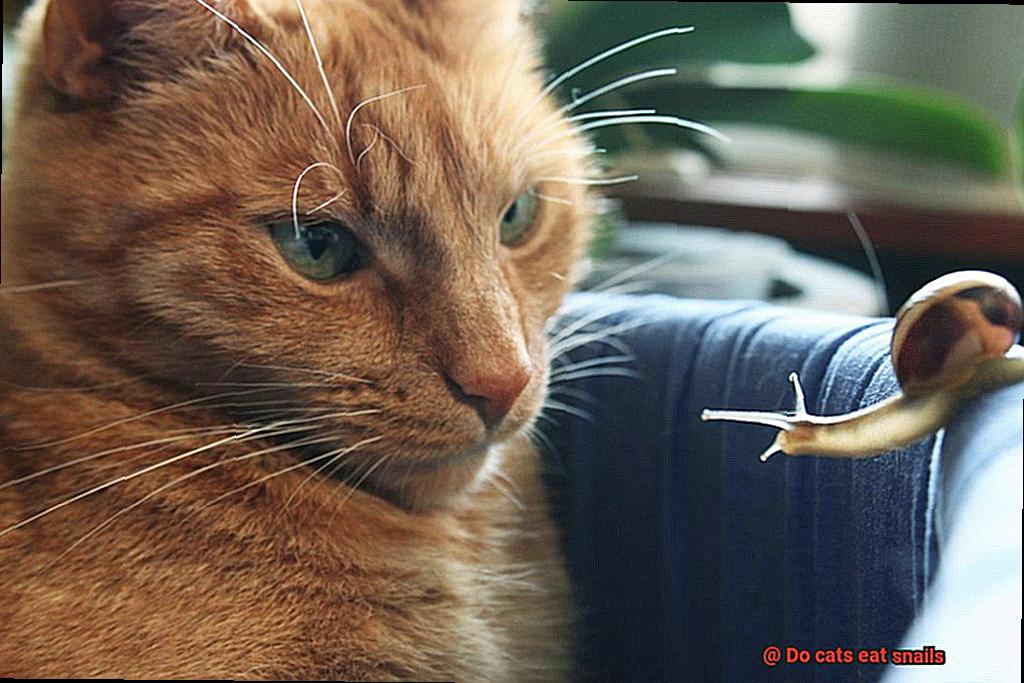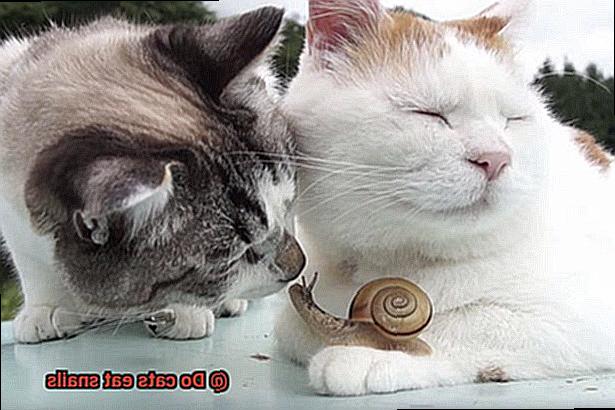Have you ever caught your curious cat playing with a slow-moving snail in your yard? Or perhaps you’ve pondered whether your feline friend would make a meal out of these slimy creatures? It’s time to unravel the mystery and answer the age-old question: do cats eat snails?
While some cats may show an interest in playing with or even eating snails, others may simply sniff them and walk away. But why are some cats attracted to these slow-moving critters? And is it safe for them to indulge their curiosity and try a snail snack?
In this post, we’ll take a deep dive into the world of cats and snails, exploring the potential risks involved with consuming them. We’ll also examine the reasons why some cats may be drawn to these mollusks, including their crunchy texture and high protein content.
So, let’s get started.
Do Cats Eat Snails?
Cats are curious creatures that love to explore their surroundings. They are natural hunters, and their prey usually consists of small rodents or birds. However, have you ever wondered if cats eat snails? Well, the answer is not so simple.
While some cats may show an interest in snails, it’s not a common food source for felines. Some cats may be drawn to snails due to their slow and sluggish movement, while others may not be interested at all. In general, cats are more likely to hunt and eat small rodents or birds rather than snails. However, if a cat does come across a snail, it may paw at it or even pick it up in its mouth out of curiosity.
It’s important to note that some species of snails can be harmful to cats if ingested. For example, the common garden snail can carry parasites such as lungworms that can cause health problems for cats. Additionally, snails may also contain harmful chemicals or pesticides if they have been exposed to such substances.
As a responsible cat owner, it’s essential to monitor your pet’s behavior around snails and ensure that they are not consuming harmful substances. If you notice that your cat is showing an interest in snails, you can discourage them from hunting these creatures by providing them with plenty of toys and activities to keep them occupied.
In conclusion, while some cats may show an interest in snails, they are not a common food source for felines. It’s important to ensure that any snails your cat comes into contact with are not harmful and to discourage any hunting behavior towards these creatures.
Reasons Why Cats May Be Attracted to Snails
Cats are known for their curious and playful nature, which includes interacting with different types of creatures. Snails, in particular, seem to be a favorite among cats. But have you ever wondered why? Here, we’ll explore five fascinating reasons why cats may be attracted to snails.
Slow Movement
Cats are natural predators and enjoy the thrill of the chase. However, fast-moving prey like birds or mice can be difficult for cats to catch. Snails, on the other hand, move at a much slower pace, making them an easy target for cats. It’s like a game of slow-motion tag for our feline friends.
Unique Smell

Snails produce a slimy mucus that gives off a distinct odor that cats find intriguing. This smell may trigger a cat’s curiosity and encourage them to investigate further. In fact, some cats may even be attracted to the scent of snails as it provides a new and interesting sensory experience.
Nutritional Value
Snails are high in protein and contain essential nutrients that cats need in their diet such as vitamins A and E. Some cat owners even give their pets snails as a treat or supplement. Cats may also instinctively seek out foods with high nutritional value, which could explain their attraction to snails.
Texture and Taste

While not all cats will be attracted to the taste or texture of snails, some may develop a liking to them over time. Snails have a slimy texture which can be appealing to some cats. They also have a unique taste that some cats may find interesting, especially if they are offered as a treat.
Individual Preferences
It’s important to note that not all cats will be interested in snails. Some may find them unappetizing or uninteresting. It ultimately depends on the individual cat’s preferences and personality. Just like humans, every cat has their own unique likes and dislikes.
In conclusion, there are several reasons why cats may be attracted to snails, including their slow movement, unique smell, nutritional value, texture and taste, and individual preferences. While it can be entertaining to watch your cat play with snails, it’s important to ensure that they are not consuming too many as they can cause digestive issues if eaten in large quantities. As always, it’s important for cat owners to monitor their pets’ behavior and provide them with a safe and nutritious diet.
Potential Risks of Eating Snails for Cats

While it may seem harmless, there are several concerns to consider.
One of the main risks is the potential for snails to carry harmful parasites or bacteria. Lungworm, which can cause respiratory issues, and salmonella, which can lead to gastrointestinal problems, are just a few examples. These unwanted hitchhikers can make their way into your cat’s system and cause serious health issues.
Another risk to consider is the possibility of snails carrying harmful toxins. Pesticides and other harmful substances could make their way into a snail’s body, posing a risk to any cat that decides to make it a snack. Poisoning is not something you want your furry friend to experience.
It’s also important to note that some cats may have an allergic reaction to snails. If you notice vomiting, diarrhea, or difficulty breathing after your cat has indulged in some snail cuisine, it’s time to call the vet.
Advice for Cat Owners
From cozy beds to endless toys and scrumptious meals, you do everything in your power to ensure their health and happiness. However, have you ever stopped to consider the potential risks associated with your curious cat’s snail-eating habits?
While it may seem like a harmless quirk, allowing your cat to munch on snails can be perilous for their well-being. Snails can harbor parasites, bacteria, and even harmful toxins that could pose serious health risks for your furry friend.
As an expert on this topic, I highly recommend that you take measures to discourage your cat from eating snails. You can start by limiting their access to areas where snails are likely to be found. Keeping your cat indoors or creating a designated outdoor area free of snails can help prevent any unwanted snail encounters.
Moreover, make sure that your cat’s food bowl is always brimming with high-quality cat food that meets their nutritional needs. This way, they won’t feel the need to seek out alternative sources of food like snails.
If you do catch your kitty indulging in some snail cuisine, it’s crucial to monitor them closely for any signs of illness. Symptoms such as vomiting, diarrhea, and lethargy can be indicative of ingesting harmful substances. If you notice any of these symptoms, don’t hesitate to seek veterinary care immediately.
SBG4v4IE5Ck” >
Conclusion
To wrap up, it’s safe to say that cats may have a passing interest in snails, but it’s not a regular part of their diet. While some felines might be tempted by the slow-moving creatures, it’s important to keep an eye on them and discourage any harmful behavior. Snails can carry parasites and toxins that could lead to severe health problems for your furry companion.
It’s worth noting that cats’ attraction to snails can vary based on their unique preferences and personalities. Some cats may find the smell, texture, or taste appealing, while others might not give them a second glance.
If you do catch your cat munching on a snail, monitor them closely for any signs of illness. Vomiting, diarrhea, or lethargy are all symptoms that could indicate they’ve ingested something harmful. If you notice any of these warning signs, don’t hesitate to seek veterinary care.







